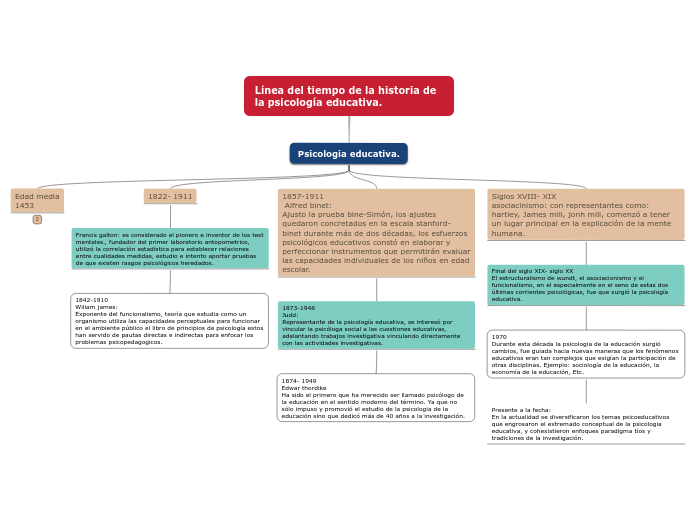Línea del tiempo de la historia de la psicología educativa.
Type in the name of the multiple-perspectives text.
Example: Bridge to Terabithia by Katherine Paterson
Psicologia educativa.
Identify an important issue from the text that is being presented from different angles. Type it in.
Example: Jesse's drawing talent.
Siglos XVIII- XIX
asociacinismo: con representantes como: hartley, James mill, jonh mill, comenzó a tener un lugar principal en la explicación de la mente humana.
Decide on the fourth point of view
Type in the name of the last character whose perspective on the issue you are going to present.
Example: Leslie Burke, Jesse's new next-door neighbor, and best friend.
Final del siglo XIX- siglo XX
El estructuralismo de wundt, el asociacionismo y el funcionalismo, en el especialmente en el seno de estas dos últimas corrientes psicológicas, fue que surgió la psicología educativa.
Point of view
Type in a relevant quote that highlights the character's point of view. Try to follow a citation format: author's name, chapter, and page.
Example: I can't get the poetry of the trees,' he said. She nodded. Don't worry,' she said. You will someday. He believed her.' (Paterson, 4. 24)
1970
Durante esta década la psicologia de la educación surgió cambios, fue guiada hacia nuevas maneras que los fenómenos educativos eran tan complejos que exigían la participación de otras disciplinas. Ejemplo: sociología de la educación, la economía de la educación, Etc.
How is the viewpoint introduced in the story?
Choose an answer:
First person point of view - using the personal pronouns 'I' or 'we'Second person point of view - using the personal pronoun 'you'Third person point of view - using the third-person pronouns 'he', 'she' and 'they'Omniscient point of view - an all-seeing observer tells the story
Presente a la fecha:
En la actualidad se diversificaron los temas psicoeducativos que engrosaron el extremado conceptual de la psicologia educativa, y cohexistieron enfoques paradigma tíos y tradiciones de la investigación.
1857-1911
Alfred binet:
Ajusto la prueba bine-Simón, los ajustes quedaron concretados en la escala stanford- binet durante más de dos décadas, los esfuerzos psicológicos educativos constó en elaborar y perfeccionar instrumentos que permitirán evaluar las capacidades individuales de los niños en edad escolar.
Whose character does the third point of view belong to?
Type in his/her name.
Example: Mr. Aarons, Jesse's father.
1873-1946
Judd:
Representante de la psicología educativa, se interesó por vincular la psicóloga social a las cuestiones educativas, adelantando trabajos investigativa vinculando directamente con las actividades investigativas.
What does the character think, say or do that suggests their perspective on the issue?
Type in a quote and try to maintain the citation format.
Example: 'He would like to show his drawings to his dad, but he didn't dare. (...) He'd thought his dad would be pleased. He wasn't. What are they teaching in that damn school? he had asked.' (Paterson, 2.8)
1874- 1949
Edwar thordike
Ha sido el primero que ha merecido ser llamado psicólogo de la educación en el sentido moderno del término. Ya que no sólo impuso y promovió el estudio de la psicologia de la educación síno que dedicó más de 40 años a la investigación.
What kind of narration introduces the viewpoint?
Choose an answer:
First person point of view - using the personal pronouns 'I' or 'we'Second person point of view - using the personal pronoun 'you'Third person point of view - using the third-person pronouns 'he', 'she' and 'they'Omniscient point of view - an all-seeing observer tells the story
1822- 1911
Decide on the second point of view
Name the character (it can either be the main character or one of the supporting characters) whose point of view you are presenting.
Example: Miss Edmunds, Jesse's music teacher.
Francis galton: es considerado el pionero e inventor de los test mentales., fundador del primer laboratorio antopometrico, utilizó la correlación estadística para establecer relaciones entre cualidades medidas, estudio e intento aportar pruebas de que existen rasgos psicológicos heredados.
Type in a quote that points out the character's position about the issue.
Try to follow a citation format: author's name, chapter, and page.
Example: 'She said he was unusually talented, and she hoped he wouldn't let anything discourage him.' (Paterson, 2. 8)
1842-1910
Wiliam james:
Exponente del funcionalismo, teoría que estudia como un organismo utiliza las capacidades perceptuales para funcionar en el ambiente público el libro de principios de psicología estos han servido de pautas directas e indirectas para enfocar los problemas psicopedagogicos.
How is the viewpoint introduced in the story?
Choose an answer:
First person point of viewSecond person point of viewThird person point of viewOmniscient point of view
Edad media
1453
Decide on the first point of view you are going to present.
Type in the name of the character (it can either be the main character or one of the supporting characters) whose point of view belongs to.
Example: Jesse Oliver Aarons, Jr., the main character of the novel, a fifth-grader living in a rural Southern area.
Rene descartes: pensaba que el conocimiento residía de las ideas innatas.
Type in a relevant quote that highlights the character's point of view towards
Psicologia educativa..
Try following a citation format: author's name, chapter, and page.
Example: 'Jesse drew the way some people drank whiskey. (...) Lord, he loved to draw. (...) When he was in first grade, he told his father that he wanted to be an artist when he grew up.' (Paterson, 2. 7)
Jonh locke: creía que las ideas no eran innatas, si no que surgían de las experiencias sensoriales y del proceso de reflexión, quiere decir que eel aprendizaje provenía de las experiencias.
What type of narration introduces the viewpoint?
Choose an answer:
First person point of view - using the personal pronouns 'I' or 'we'Second person point of view - using the personal pronoun 'you'Third person point of view - using the third-person pronouns 'he', 'she' and 'they'Omniscient point of view - an all-seeing observer tells the story









